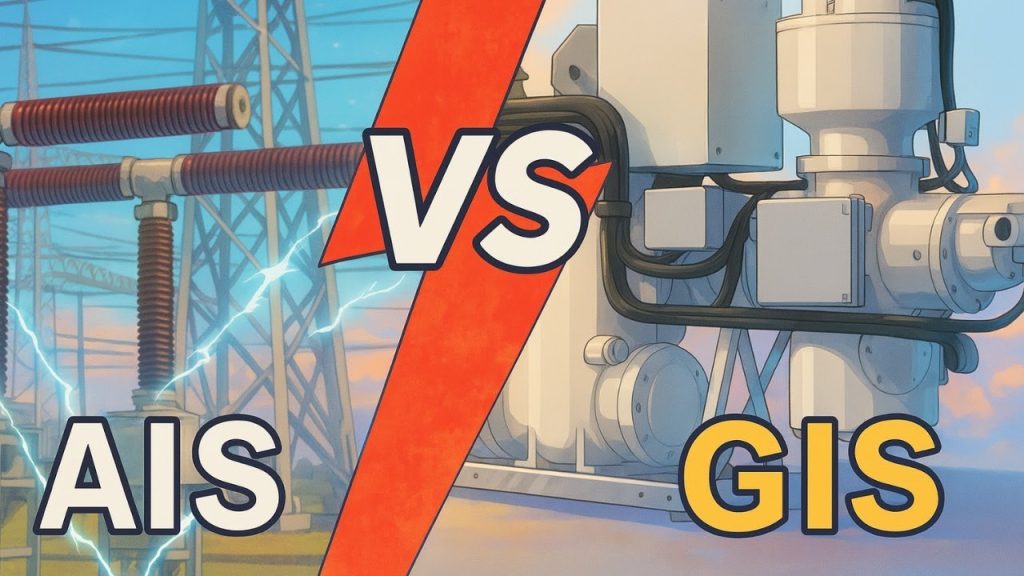
AIS vs GIS Substation: How the Selection is Made
AIS vs GIS Substation: How the Selection is Made https://www.theelectricalguy.in/wp-content/uploads/2025/08/maxresdefault-3-1024x576.jpg 1024 576 Gaurav Joshi Gaurav Joshi https://secure.gravatar.com/avatar/8d621b67d3005addbda23477c1259921ee1db2decf01a4f473bf0e5c76f3933a?s=96&d=mm&r=gChoosing between AIS vs GIS substations is not always as straightforward as it seems in textbooks. A detailed analysis presented in CIGRE’s reference work on high-voltage substations suggests that mixed-technology switchgear should be the first choice, followed by gas-insulated systems, and lastly air-insulated systems. But when you look at real-world projects, the picture is very different.
Most substations today still rely on air-insulated technology, with gas-insulated systems coming next, and mixed technology appearing only rarely. Most substations across the world still use air-insulated switchgear, followed by the gas-insulated and then hybrid systems used far less often. Why does this gap exist between theory and practice? To answer this, let’s look at each technology, its pros and cons, and the conditions where it fits best.
Table of Contents
- Understanding Switchgear Technologies
- Why All Three Work Well
- Air Insulated Switchgear (AIS)
- Mixed Technology Switchgear (MTS)
- Gas Insulated Switchgear (GIS)
- Comparing AIS vs GIS Substation
- How Selection is Made
- Why Theory and Practice Differ
- Conclusion
Understanding Switchgear Technologies
Substations use switchgear for control, protection, and insulation. There are three main types:
Air Insulated Switchgear (AIS)
AIS uses atmospheric air as the insulating medium. The gap between conductors and equipment provides the necessary insulation.
Gas Insulated Switchgear (GIS)
GIS replaces air with insulating gases such as SF6. This makes the setup compact, powerful, and safe.
Mixed Technology Switchgear (MTS)
MTS combines AIS and GIS. It is a hybrid that balances cost, size, and performance.
All three serve the same purpose: safe and efficient substation operation. The difference lies in how they deliver this purpose.
Why All Three Work Well
Think of it as choosing between a bus, a train, or a flight. Each option takes you to the same destination but with different routes, speeds, and costs. Similarly, AIS, GIS & MTS technologies achieve the same goal but through different designs. The right choice depends on cost, space, location, and environment and other project specific factors.
Air Insulated Switchgear (AIS)
Popularity of AIS
Even today, around 70% of high-voltage substations worldwide rely on AIS*. The main reason for this dominance is simple: cost. Among all technologies, AIS continues to be the most economical option.
Advantages of AIS
- Low cost: Cost Effective than GIS or MTS.
- Easy expansion: Adding new bays or transformers is simple.
- Reliable: Works well when land is available.
Because of these strengths, AIS is the first choice in many projects.
Disadvantages of AIS
- Space demand: AIS needs large land areas because air requires wide clearance distances.
- Weather limits: It struggles in polluted or coastal regions where air insulation weakens.
Where AIS is Chosen
AIS fits best in rural or semi-urban areas where land costs are low and pollution is minimal. Many rural substations still rely on AIS for this reason.
Mixed Technology Switchgear (MTS)
What is MTS?
MTS blends AIS and GIS. For example, the breaker, disconnector, and current transformer may come in a compact GIS module, while other equipment stays in AIS form.
Advantages of MTS
- Space saving: More compact than AIS.
- Cost balance: Cost Effective than full GIS.
- Handles mild pollution: Performs better than AIS in slightly polluted conditions.
Limitations of MTS
- Less common: Rarely used compared to AIS or GIS.
- Higher cost than AIS: While cost effective than GIS, it still costs more than air-insulated systems.
Where MTS is Used
MTS becomes useful in extensions. Suppose an existing AIS substation needs an extra bay but has limited space. Instead of switching fully to GIS, engineers may use MTS. At a 66/11 kV substation I observed, one bay was designed entirely with AIS while the adjacent bay used MTS.
The reason was a limitation of space, which made it impractical to install another dedicated AIS bay. This hybrid approach offered a smart balance, optimizing available space while keeping costs under control.
Gas Insulated Switchgear (GIS)
What Makes GIS Different?
Among all types, GIS offers the most advantages. It is compact, safe, and nearly maintenance-free. GIS uses insulating gas (like SF6) in place of the air. Since the dielectric properties of SF6 is very much higher than the air, the complete switchgear can be built with a smaller footprint.
Advantages of GIS
- Space efficiency: Up to 10 times smaller than AIS.
- Safety: Equipment is enclosed in grounded metal, reducing risk.
- Low maintenance: Needs little servicing compared to AIS.
- Environmental protection: Performs well in harsh conditions.
- Aesthetic design: Can be installed inside buildings, keeping the system hidden.
Disadvantages of GIS
- High cost: The most expensive option.
- Difficult expansion: Adding another bay is complex.
- Troubleshooting issues: Failures are rare, but when they occur, fixing them is tough.
Where GIS is Chosen
GIS fits in:
- Urban areas: Where land is scarce and costly.
- Industrial zones: Where pollution and space are challenges.
- Metro stations and crowded areas: Where aesthetics and compactness matter.
- Harsh environments: Resistant to dust, chemicals, and coastal pollution.
GIS often becomes the only practical choice in cities where land is too expensive for AIS.
Comparing AIS vs GIS Substation
To better understand the selection, let’s compare the two most widely used systems:
| Factor | AIS | GIS |
| Cost | Low | High |
| Space | Requires large land | Compact, can get 10x smaller |
| Expansion | Easy | Complex |
| Maintenance | Moderate | Very low |
| Pollution resistance | Low | High |
| Safety | Moderate | Very high |
| Best suited for | Rural or semi-urban | Urban, industrial, polluted zones |
This simple comparison shows why both types still exist. AIS rules in areas with cheap land and low pollution, while GIS dominates cities and industries where space and safety matter more.
How Selection is Made
The choice between AIS vs GIS substation depends on several factors:
- Location: Rural favors AIS, urban favors GIS.
- Land cost: AIS where land is cheap, GIS where land is costly.
- Pollution levels: AIS for clean environments, GIS for polluted ones.
- Budget: AIS for low-cost projects, GIS for high-budget setups.
- Expansion needs: AIS is flexible, GIS is rigid.
- Aesthetics: GIS fits modern buildings, AIS stays outdoors.
Every project is unique. Engineers look at cost, geography, and environmental needs, project specific limitations and other factors before making a final choice.
Why Theory and Practice Differ
Textbook studies may give GIS or MTS higher preference. But in practice, AIS still dominates because of cost and flexibility. While GIS offers many benefits, its price keeps it limited to cities and industries. MTS has potential but is still less popular due to its higher cost compared to AIS.
Conclusion
When we compare AIS vs GIS substation, both serve the same purpose but under different conditions. AIS wins in rural and semi-urban settings where land is cheap and pollution is low. GIS becomes the right choice in cities, industrial areas, and harsh environments where space, safety, and aesthetics matter most. MTS sits in the middle, used mainly for expansions where space is limited but full GIS is too costly.
Every project is different, so the selection depends on many factors. To see detailed visuals and real examples, you can watch the full video by TheElectricalGuy. It provides a clearer picture of how these technologies work in practice.

- Posted In:
- Switchgear
Gaurav Joshi
Gaurav, also known as TheElectricalGuy, is an accomplished electrical engineer with over 8 years of experience in the high and medium voltage switchgear industry. In addition to his professional endeavors, Gaurav has made significant contributions to the global electrical engineering community through his highly successful YouTube Channel. With over 195K subscribers and a prestigious silver play button from YouTube, he has become a trusted resource for electrical engineers worldwide. Gaurav's dedication to sharing knowledge extends to the creation of comprehensive courses, which have already attracted over 3000 students eager to enhance their skills in the field.
All stories by: Gaurav Joshi

